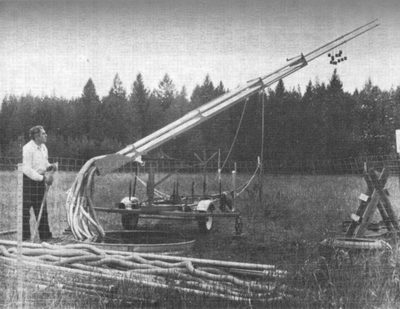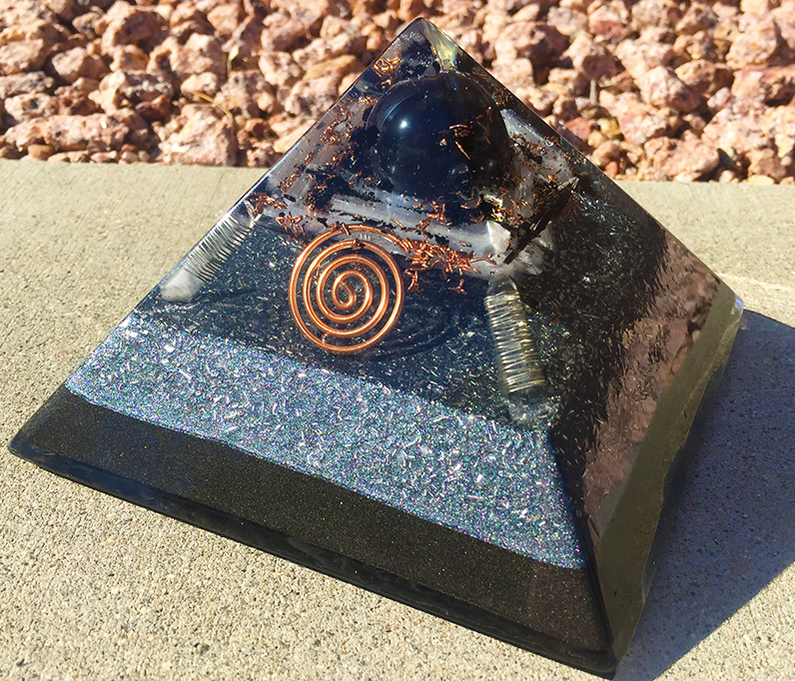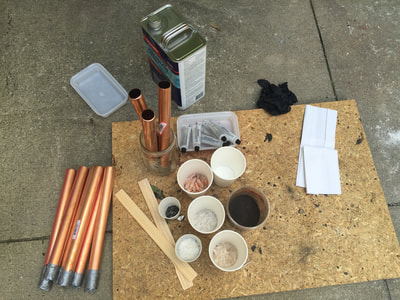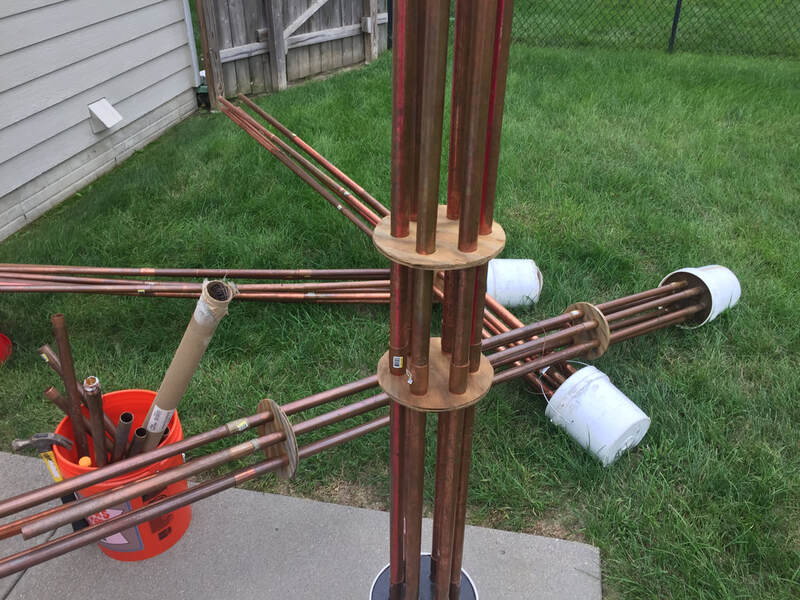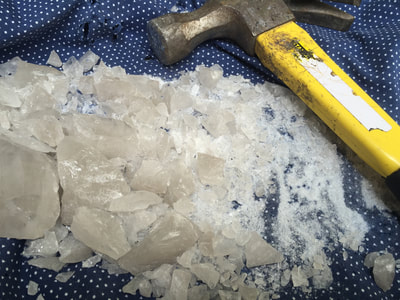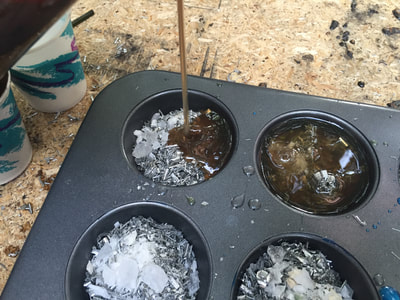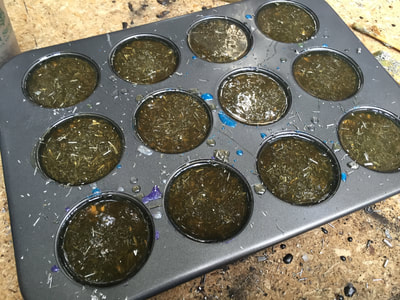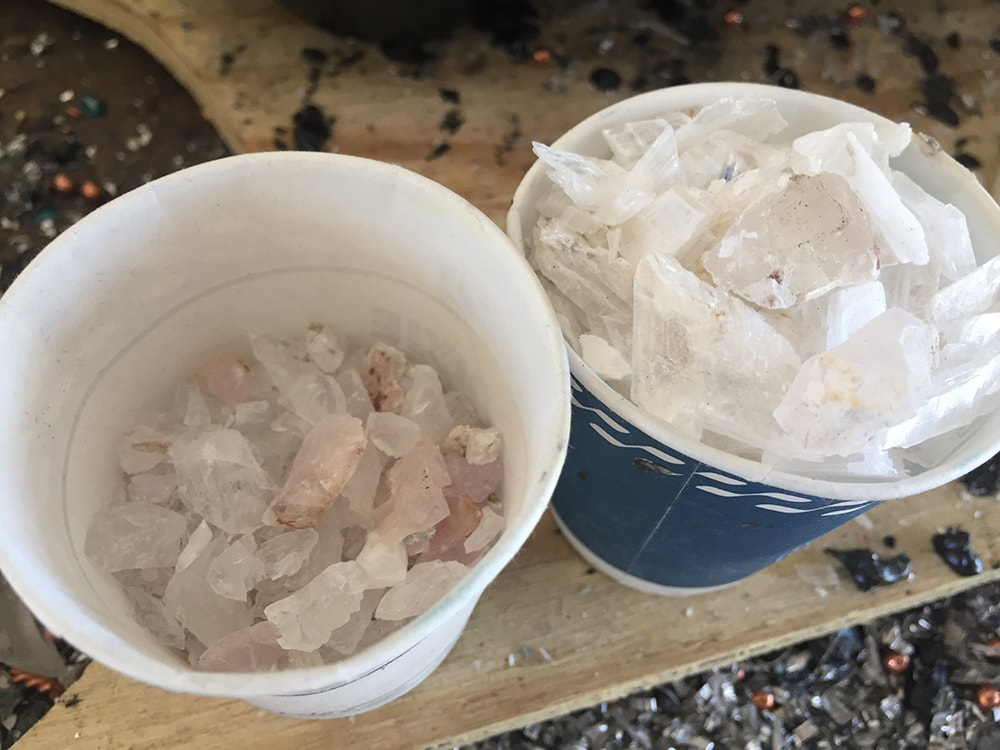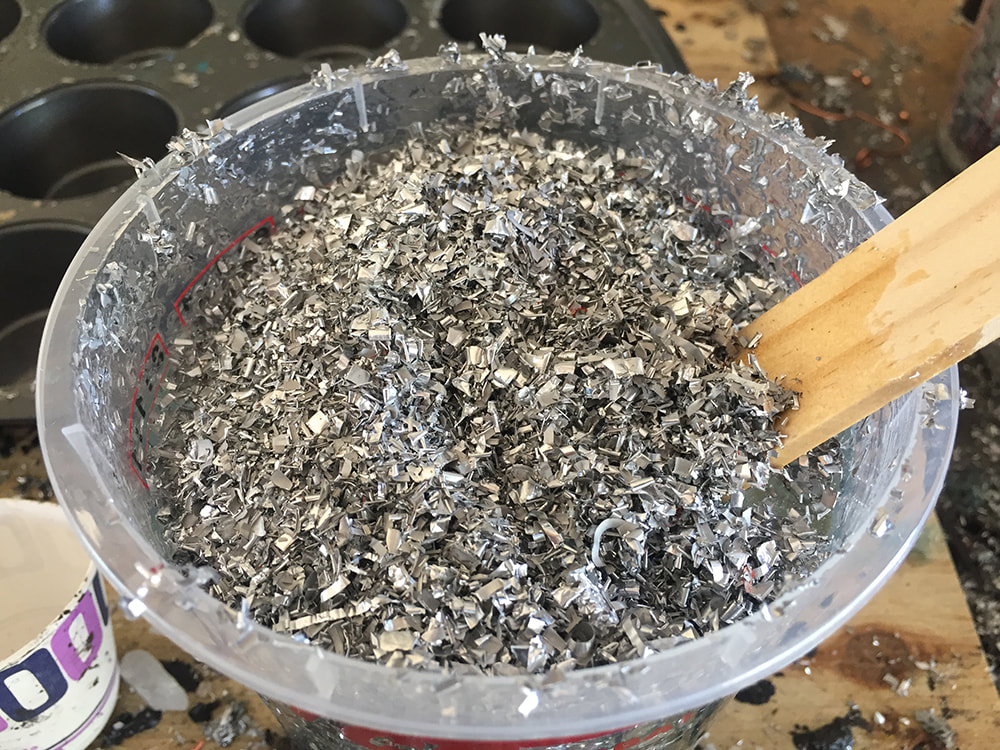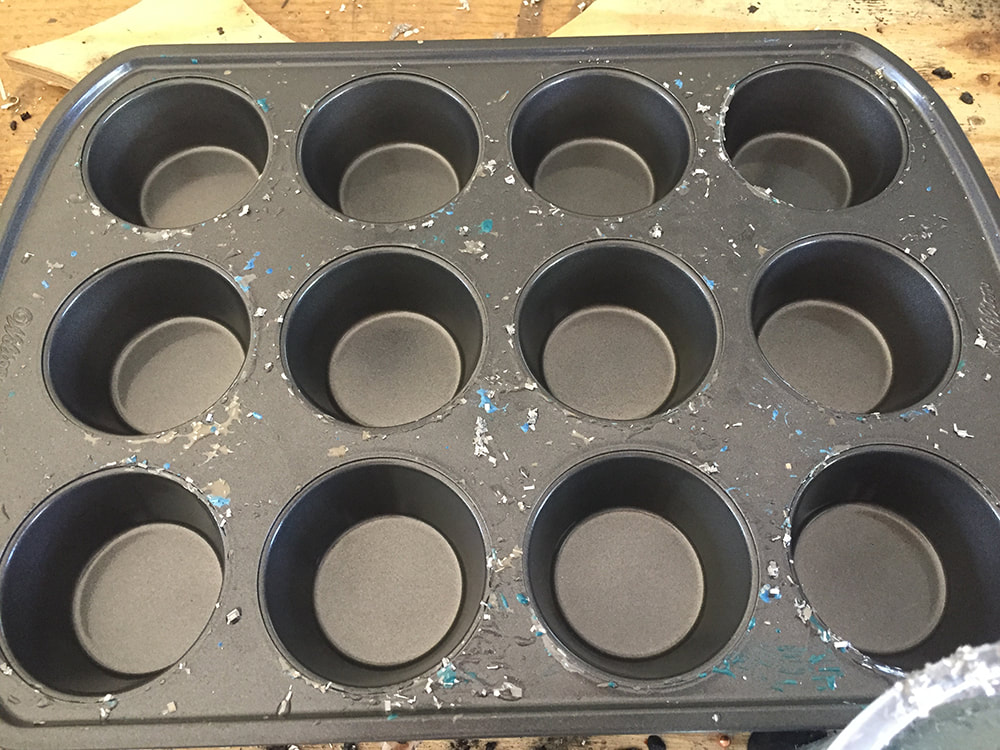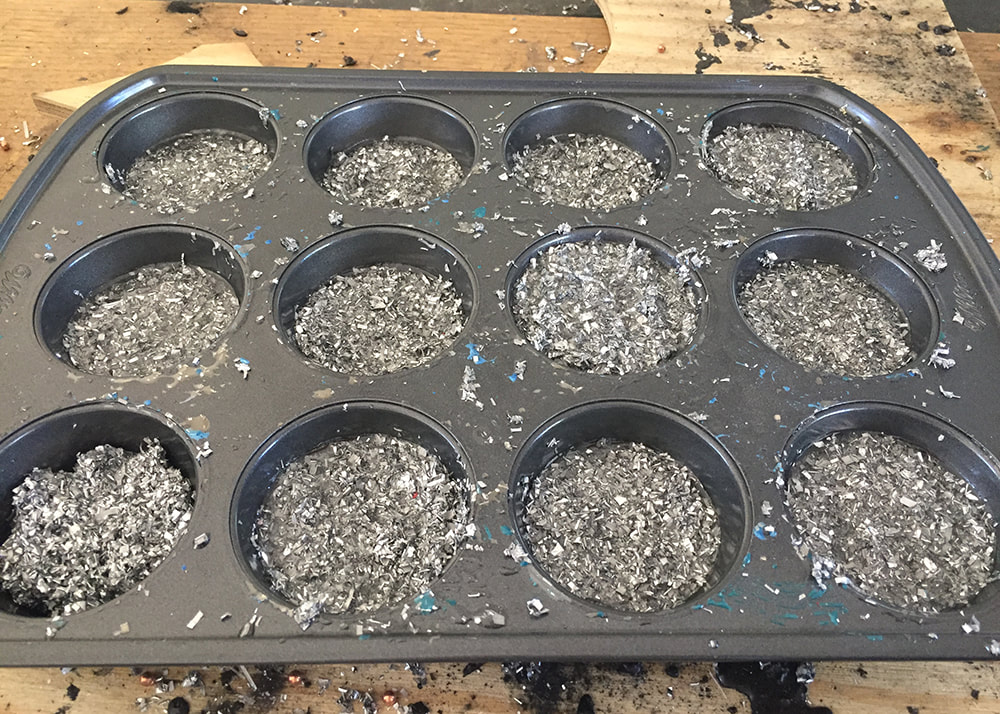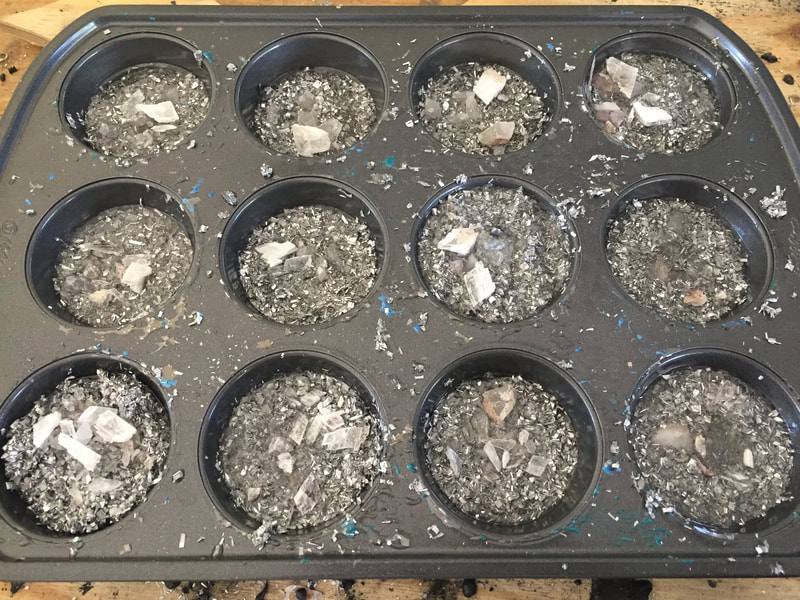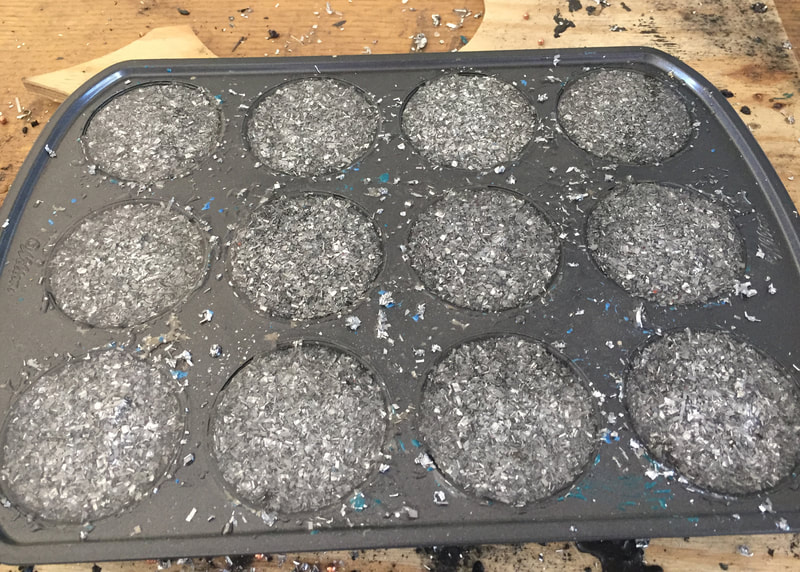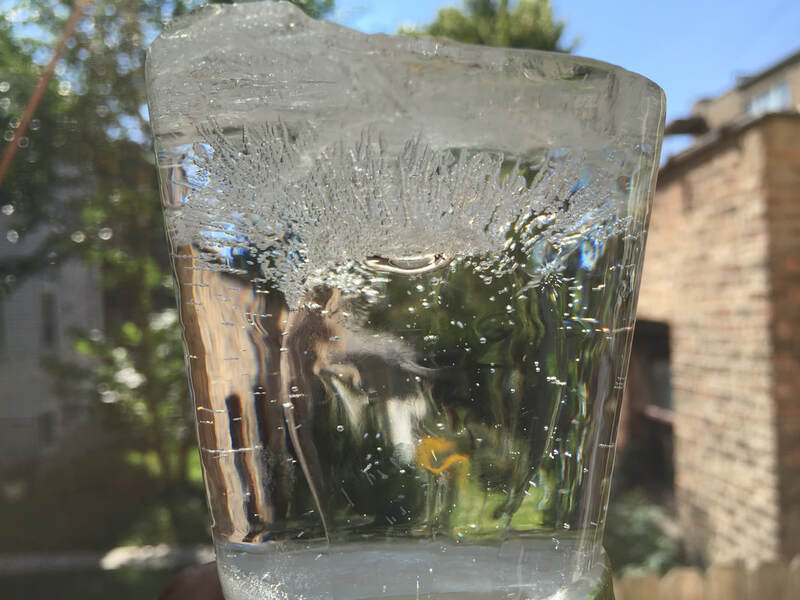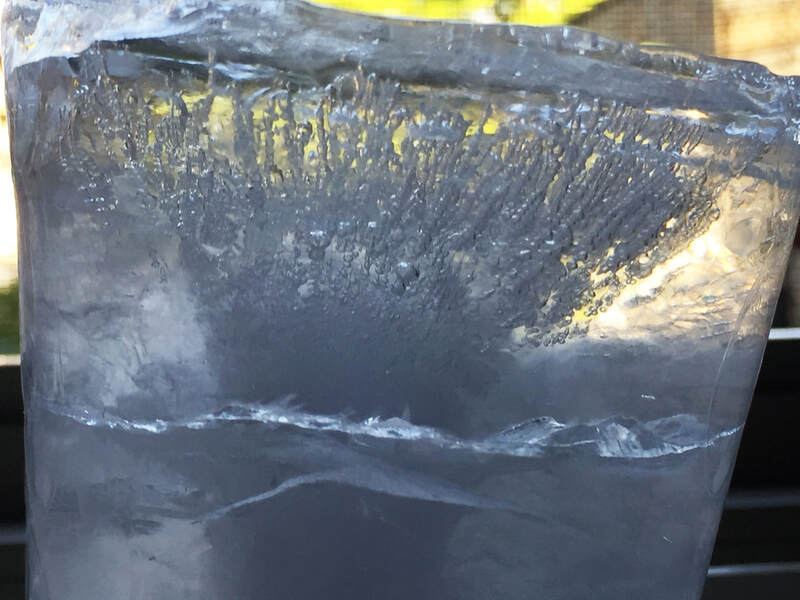Orgone Energy
Orgone Energy is the universal life energy that permeates everything in the universe. Orgone has many different names. In physics, it is known as scalar energy. In many cultures it is referred to as chi, prana, torsion, ether, and in some cases zero-point energy. If life were a Starwars film, it would be equivalent to the Force. It is the energy of life.
When you first hear the term “Orgone,” you no doubt hear the name Dr. Wilhelm Reich; the Austrian scientist credited with discovering the universal life energy, which he termed “Orgone energy” before ultimately meeting his demise because of his discovery. If you visit a website about Orgone, you’ll hear the same points. He was Austrian, a student of Sigmund Freud, and he discovered a bio-electrical charge in the human body and figured out a way to accumulate and harness the energy to treat human beings with cancer and infertility among other ailments, and neurosis that came from being out of alignment with the universal life energy of Orgone.
Reich was big on understanding neurosis and sexuality, and termed the energy “Orgone” after the word “orgasm.” In the simplest form, Orgone is sexual energy, and Reich made a scientific connection between the mind, body and overall energy being out of alignment from healthy orgone (or sexual energy), which resulted in an increased likelihood for having illnesses and neurosis.
When you first hear the term “Orgone,” you no doubt hear the name Dr. Wilhelm Reich; the Austrian scientist credited with discovering the universal life energy, which he termed “Orgone energy” before ultimately meeting his demise because of his discovery. If you visit a website about Orgone, you’ll hear the same points. He was Austrian, a student of Sigmund Freud, and he discovered a bio-electrical charge in the human body and figured out a way to accumulate and harness the energy to treat human beings with cancer and infertility among other ailments, and neurosis that came from being out of alignment with the universal life energy of Orgone.
Reich was big on understanding neurosis and sexuality, and termed the energy “Orgone” after the word “orgasm.” In the simplest form, Orgone is sexual energy, and Reich made a scientific connection between the mind, body and overall energy being out of alignment from healthy orgone (or sexual energy), which resulted in an increased likelihood for having illnesses and neurosis.
After discovering Orgone and using his accumulators and cloud busters to cure patients of ailments like infertility, as well as to treat cancer patients and restore the natural rain cycle in places like the Arizona desert, news of Reich’s work eventually garnered the attention of the US government. The FDA, US judicial system, and even the military required him to destroy his devices, he was thrown in prison, and was mysteriously murdered days before his release. Funny how that happens, am I right?
Reich, the Orgone Accumulator, and the Cloud Buster
As an Orgone energy worker and avid maker and gifter, I find Reich absolutely fascinating, while many would find his research and books a bit dry. Reich is the first word mentioned when most people give their canned response to Orgone energy and Orgonite, the name once used to describe most Orgone devices. Ironically, if Reich were to alive today, it’s doubtful he would recognize an "orgonite" device, yet many in the Orgone circles immediately make the Reich and orgonite connection. The inventor of orgonite is a man named Karl Hans Welz. Keep reading below for more on that guy.
You might notice a lot of energy workers are no longer using the term “orgonite” to classify their devices. The reason for this is because the person who created the first device that could be classified as orgonite, Karl Welz, has allegedly decided to trademark the term and pursue some questionably shady antics in the process. I stress the word "allegedly" here because I don't know the full situation, and frankly I don't care. Comedic legal theatrics aside, there are many amazing energy workers who have allegedly been threatened with legal action by this person who trademarked the name of a device that is doing good things to end the powers-that-were. I've never met him personally, but word through the grapevine is he's allegedly stalking on my website, social media, and blog (Hi Karl, I see you)!
So pushing forward, Orgone workers now refer to their devices as Orgone energy devices, Orgone Towerbusters, Orgone Pyramids, etc. I use these terms too, but still maintain the belief that anyone legally attacking energy workers who are spreading the awareness of what this amazing technology can do is someone with a serious parasitic chip on their shoulders, in need of some serious human compassion. In addition, I'm not keen on Orgone workers who only make devices for sale and never gift to the planet to stop geoengineering. There are millions of HAARP weapons around the planet, and they all need gifting. I share this because the most common question I get from people is "who do you recommend" regarding where to learn more and where to buy devices. Simple; from me, at theorgonedonor.com. I've been researching Reich for two years, I've gifted thousands of Orgone devices around the country and I thoroughly documented my work, and the sales of my shop go right back into gifting efforts.
What is Orgonite?Again, it's important to know that the term "Orgonite" has been shaken up due to the cunning shrew using the US legal system to issue cease and desist orders on individuals who sell any devices named "orgonite." Today, the energy workers of the world typically use the term "Orgone device" because the name Orgone energy cannot be trademarked.
An Orgone device is a energy device that is composed of three core materials; quartz crystals, metal shavings, and a catalyzing resin. Other materials often include various crystals and rocks, such as selenite, copper coils, as well as fine metal powders and catalyzing resin alternatives. Many types of crystal can be used to make it, but quartz, which is composed of silicon dioxide, behaves a certain way when pressure is applied to it. In this case, the resin compresses the quartz, which activates its piezoelectric charge. This charge is released as scalar waves. Scalar energy is another term for Orgone energy, and this energy is amplified during this process when making Orgone devices. |
How Do Orgone Devices Work?
Orgone energy devices, like the towerbuster, are made from an equal mixture of catalyzing resin and metal shavings, and quartz crystals. Additionally, a copper coil is often added. Most crystals can be used in Orgone devices, but quartz is the most effective, due to it's piezoelectric properties, meaning its scalar wave energy is amplified by putting pressure on it. When the resin catalyzes, it puts pressure on on the quartz, activating this effect. While some pieces can be made without using quartz as the main crystal, I personally use quartz in all of my devices and have never done otherwise, specifically because of the scalar wave effect.
When the resin catalyzes around the crystal, the compression activates its scalar energy. The metal shavings amplify the energy, and the copper coil assists in directing negative ions (orgone devices are negatively ionizing, which offsets the positive ionization in the atmosphere from EMF devices, electrosmog, pollution, etc.). Negative ions clean the environment, and promote the hydrogen bond, forming water molecules. Once an environment is negatively ionized and cloud can occur naturally, the result is healthy rain cloud formation and rainfall. Orgone energy is free energy, in that it is accumulating, generating, and harnessing the life force energy of the universe, like a quantum receiver or key. This energy is fractal waves and moves faster than the speed of light, and this is the energy perpetually generated by Orgone devices. This Orgone energy, aka scalar energy, transmutes negative energy back into a harmonious state.
Some energy workers and scientists suggest cleaning Orgone devices by rinsing them in water to recharge, or placing in sunlight, as this will benefit crystals, but this is not necessary for it to function as it should and will still continue to transmute negative EMF.
When the resin catalyzes around the crystal, the compression activates its scalar energy. The metal shavings amplify the energy, and the copper coil assists in directing negative ions (orgone devices are negatively ionizing, which offsets the positive ionization in the atmosphere from EMF devices, electrosmog, pollution, etc.). Negative ions clean the environment, and promote the hydrogen bond, forming water molecules. Once an environment is negatively ionized and cloud can occur naturally, the result is healthy rain cloud formation and rainfall. Orgone energy is free energy, in that it is accumulating, generating, and harnessing the life force energy of the universe, like a quantum receiver or key. This energy is fractal waves and moves faster than the speed of light, and this is the energy perpetually generated by Orgone devices. This Orgone energy, aka scalar energy, transmutes negative energy back into a harmonious state.
Some energy workers and scientists suggest cleaning Orgone devices by rinsing them in water to recharge, or placing in sunlight, as this will benefit crystals, but this is not necessary for it to function as it should and will still continue to transmute negative EMF.
How to Make Orgone Devices
Please visit my Downloads, Instructions, and Tutorials Page for specifics on making different Orgone devices.
The basic recipe for traditional orgone devices is a 1:1 mixture of catalyzing resin and metal shavings with the addition of some form of quartz crystals. The following is specific to towerbusters. If it's your first time working with resin or making Orgone devices, start with something simplistic like Bondo Fiberglass Resin. While some are not a fan of the amber color of the resin, the instructions and catalyst make it easy to use and fairly foolproof. The average cost of Bondo per one-gallon container is approximately $40 (as of May 2021). One gallon, if used correctly, should be enough to create approximately 40 to 48 towerbusters, depending on other factors, such as the density and volume of the metal components, crystals, and the size of the mold being used.
The general consensus in the Orgone community is that a towerbuster should be approximately three ounces or more, which is easy to accomplish when using the tried-and-true muffin pan method. Yes, those hockey pucks you see are created by some form of muffin or cupcake mold. PS, Orgonite is not edible, so please do not eat it (there's always that one person)...
***SAFETY NOTE: Resin is typically toxic until cured, so please use caution and proceed at your own risk. Also, be sure to follow the manufacturer's instructions, and use safety gear, including some form of protective wear for your hands (rubber or nitrile gloves), and a respirator. I use a 3M 6300 series, which includes carbon filters for organic solvents and fumes, as well as filters for particulate matter (which comes in handy if you plan to sand/polish the final pieces).
Aluminum is considered the optimal metal for making tactical towerbusters for a few reasons. It's lightweight, easily accessible, budget-friendly, and versatile. If you're planning to bust a large number of towers, you'll be thankful you used aluminum when carrying 100 towerbusters inside a backpack or on your bike. Other common metals can include brass, steel, iron, and copper, although copper shavings are quite expensive, and I personally don't recommend using them for tactical towerbusting pieces that you plan to gift or bury. Copper is an excellent energy conductor, but again, if you've ever been out in the field busting towers strategically, you understand why light weight devices are key.
The quartz crystals may be terminated points (which just means one or both sides have a definitive point, whether natural or artificially cut), but terminated pieces are not required for functional Orgone devices like towerbusters, however, earth pipes, do require at least one small terminated quartz point, as the point will direct the energy into the ground when the pipe is buried accordingly. Visit my tutorials page to learn more about earth pipes.
The quartz component may consist of larger pieces you've broken with a hammer (use a cloth if doing this), as well as pebbles, shards, sand, or dust. If using sand, it should be from quartz that you crushed yourself. Do not use quartz sand from the home repair store (used for concrete and other home projects) because it is not entirely the same thing as quartz (silicon dioxide). It has fillers of other cheap material. While quartz crystals are the standard, most Orgone workers including myself will also add other elements, such as selenite powder, usually crushed into fragments and small pieces, or in some cases crushed into dust. Selenite is not required for functional Orgone devices. The idea stems from the community of gifters over the last two decades and the idea of Selenite being an excellent energy field cleaner. Many will interpret this to mean Orgone devices need to be cleaned; however, it does not mean that at all. The practice of cleaning Orgone devices, grounding them, washing with water, or incorporating cleansing crystals in addition to quartz is really just a matter of personal preference. If someone tells you that Orgone devices require cleaning, then I don't think they're making Orgonite, because it is already a self-cleaning energy device (assuming it's constructed properly).
In the examples below, I highlight the method for tactical-based towerbusters using aluminum shavings. The specific aluminum material I use is a bit smaller than standard shavings, almost more like fleck, which makes it fluffier than other metal shavings such as iron, which are more dense. The resin/metal rule (50 percent resin, 50 percent metal shavings) is primarily measured in volume, not weight. This makes sense when the metal is lighter and takes up more volume. The standard towerbuster is about three to four ounces, so if measuring by weight then that would be more aluminum than could physically fit inside the muffin pan mold. While the three ounce rule is important, sometimes you will have to "eye-ball it." I have made towerbusters using copper shavings too, and while they are a fantastic material for producing solid and strong Orgone devices, it takes a lot of copper shavings to fill the same volume of the muffin cavity if using only copper. For this reason, you don't want to use copper for large-scale gifting unless your budget is massive. If you want a top-notch copper shavings distributor, let me know and I'll send you their information. Be warned, it comes with a hefty price tag.
***SIDE NOTE: Check with your local key cutters, locksmiths, and brake repair shops for brass and iron, and check with fabricators and manufacturers for aluminum. In my experience, people love helping and will throw you a bone if you tell them it's for a science project. In my experience, this is not true if you say it's for an art project. Someone will inevitably ask, so just be honest. I always told people in Chicago that I was making technology devices for protecting people from the harmful effects of cell towers and EMF radiation. Throw out Tesla's name too. The response was always positive, even if they didn't have shavings or other metals to give me. In honesty, you're helping the planet. There's no negative way to cut this planetary pie.
Making Orgone Towerbusters (the Muffin Pan Process)
Because my own aluminum source includes fleck that is smaller than regular shavings, this method can vary and it's best for the individual to use their own judgment in how the material is mixed together. Sometimes you will fill a mold with metal and then pour resin over the top to fill in the gaps and equal out. Other times you will mix the resin and metal together into a sludge using a mixing container (I call it the milkshake method) and then dump the entire mixture into the mold at the same time. You then place crystals inside. Read below for specifics. The overall point is you want a mixture of resin and metal to be cast in a mold and for some form of quartz to be embedded within the mixture.
1. Fill each cavity about half-way with the metal shavings. This works best when your shavings are larger, like pencil sharpener shavings or turnings.
2. Add a few nuggets or pebbles of crushed quartz. It doesn't need to be much. Imagine a scoop approximately the size of a 1/2 teaspoon or the equivalent of a 5-10 BBs or mini ball bearings. You can add more, but it's not necessary.
3. Top off each cavity with a little bit more aluminum shavings so that it is level or close to level with the top of the muffin cavity. Don't shake the pan or level-out the shavings too much or the pile will become too dense to let resin pass through it when you pour it over the top.
4. Using an appropriate mixing container (like pain cups from the hardware store), mix your resin with the catalyst according to the makers' instructions. Many orgone workers would have you believe this is simple, and for the most part it is; however, resin will behave differently in certain environments. It is easily affected by temperature, humidity, and the other elements that are mixed in the mixture. If the temperature is below 70 degrees, you will need to use a little bit of extra catalyst solution (5-10 drops per quart of resin used, so not too much). If you're making your devices in temperatures above 70 degrees, just follow the instructions, and if using resin during a full-blown heatwave then try adding slightly less catalyst than needed so it doesn't harden to quickly or overheat and crack (If you're working quickly, then you don't have to add less, just be prepared to work quickly. Once you mix the catalyst, the resin will thicken and begin to cure in about 5-7 minutes. On a super hot day or when the resin starts out warmer prior to mixing due to higher ambient temperatures, then it will begin to thicken and cure in about 3-5 minutes. In my experience, working with resin is a guess and check process. It's not a huge learning curve, but there's still a small curve. It's just part of the process.
***Please Note: If you're mixing the resin and metal together as a whole before pouring it into the mold, the general rule is approximately 32 ounces of resin per dozen towerbusters. This is my personal method, and I use 32 ounces (volume) in aluminum shavings mixed together. The mixture is very thick, almost "too thick," to stir, but when scooped into the muffin pan/mold it levels out.
The basic recipe for traditional orgone devices is a 1:1 mixture of catalyzing resin and metal shavings with the addition of some form of quartz crystals. The following is specific to towerbusters. If it's your first time working with resin or making Orgone devices, start with something simplistic like Bondo Fiberglass Resin. While some are not a fan of the amber color of the resin, the instructions and catalyst make it easy to use and fairly foolproof. The average cost of Bondo per one-gallon container is approximately $40 (as of May 2021). One gallon, if used correctly, should be enough to create approximately 40 to 48 towerbusters, depending on other factors, such as the density and volume of the metal components, crystals, and the size of the mold being used.
The general consensus in the Orgone community is that a towerbuster should be approximately three ounces or more, which is easy to accomplish when using the tried-and-true muffin pan method. Yes, those hockey pucks you see are created by some form of muffin or cupcake mold. PS, Orgonite is not edible, so please do not eat it (there's always that one person)...
***SAFETY NOTE: Resin is typically toxic until cured, so please use caution and proceed at your own risk. Also, be sure to follow the manufacturer's instructions, and use safety gear, including some form of protective wear for your hands (rubber or nitrile gloves), and a respirator. I use a 3M 6300 series, which includes carbon filters for organic solvents and fumes, as well as filters for particulate matter (which comes in handy if you plan to sand/polish the final pieces).
Aluminum is considered the optimal metal for making tactical towerbusters for a few reasons. It's lightweight, easily accessible, budget-friendly, and versatile. If you're planning to bust a large number of towers, you'll be thankful you used aluminum when carrying 100 towerbusters inside a backpack or on your bike. Other common metals can include brass, steel, iron, and copper, although copper shavings are quite expensive, and I personally don't recommend using them for tactical towerbusting pieces that you plan to gift or bury. Copper is an excellent energy conductor, but again, if you've ever been out in the field busting towers strategically, you understand why light weight devices are key.
The quartz crystals may be terminated points (which just means one or both sides have a definitive point, whether natural or artificially cut), but terminated pieces are not required for functional Orgone devices like towerbusters, however, earth pipes, do require at least one small terminated quartz point, as the point will direct the energy into the ground when the pipe is buried accordingly. Visit my tutorials page to learn more about earth pipes.
The quartz component may consist of larger pieces you've broken with a hammer (use a cloth if doing this), as well as pebbles, shards, sand, or dust. If using sand, it should be from quartz that you crushed yourself. Do not use quartz sand from the home repair store (used for concrete and other home projects) because it is not entirely the same thing as quartz (silicon dioxide). It has fillers of other cheap material. While quartz crystals are the standard, most Orgone workers including myself will also add other elements, such as selenite powder, usually crushed into fragments and small pieces, or in some cases crushed into dust. Selenite is not required for functional Orgone devices. The idea stems from the community of gifters over the last two decades and the idea of Selenite being an excellent energy field cleaner. Many will interpret this to mean Orgone devices need to be cleaned; however, it does not mean that at all. The practice of cleaning Orgone devices, grounding them, washing with water, or incorporating cleansing crystals in addition to quartz is really just a matter of personal preference. If someone tells you that Orgone devices require cleaning, then I don't think they're making Orgonite, because it is already a self-cleaning energy device (assuming it's constructed properly).
In the examples below, I highlight the method for tactical-based towerbusters using aluminum shavings. The specific aluminum material I use is a bit smaller than standard shavings, almost more like fleck, which makes it fluffier than other metal shavings such as iron, which are more dense. The resin/metal rule (50 percent resin, 50 percent metal shavings) is primarily measured in volume, not weight. This makes sense when the metal is lighter and takes up more volume. The standard towerbuster is about three to four ounces, so if measuring by weight then that would be more aluminum than could physically fit inside the muffin pan mold. While the three ounce rule is important, sometimes you will have to "eye-ball it." I have made towerbusters using copper shavings too, and while they are a fantastic material for producing solid and strong Orgone devices, it takes a lot of copper shavings to fill the same volume of the muffin cavity if using only copper. For this reason, you don't want to use copper for large-scale gifting unless your budget is massive. If you want a top-notch copper shavings distributor, let me know and I'll send you their information. Be warned, it comes with a hefty price tag.
***SIDE NOTE: Check with your local key cutters, locksmiths, and brake repair shops for brass and iron, and check with fabricators and manufacturers for aluminum. In my experience, people love helping and will throw you a bone if you tell them it's for a science project. In my experience, this is not true if you say it's for an art project. Someone will inevitably ask, so just be honest. I always told people in Chicago that I was making technology devices for protecting people from the harmful effects of cell towers and EMF radiation. Throw out Tesla's name too. The response was always positive, even if they didn't have shavings or other metals to give me. In honesty, you're helping the planet. There's no negative way to cut this planetary pie.
Making Orgone Towerbusters (the Muffin Pan Process)
Because my own aluminum source includes fleck that is smaller than regular shavings, this method can vary and it's best for the individual to use their own judgment in how the material is mixed together. Sometimes you will fill a mold with metal and then pour resin over the top to fill in the gaps and equal out. Other times you will mix the resin and metal together into a sludge using a mixing container (I call it the milkshake method) and then dump the entire mixture into the mold at the same time. You then place crystals inside. Read below for specifics. The overall point is you want a mixture of resin and metal to be cast in a mold and for some form of quartz to be embedded within the mixture.
1. Fill each cavity about half-way with the metal shavings. This works best when your shavings are larger, like pencil sharpener shavings or turnings.
2. Add a few nuggets or pebbles of crushed quartz. It doesn't need to be much. Imagine a scoop approximately the size of a 1/2 teaspoon or the equivalent of a 5-10 BBs or mini ball bearings. You can add more, but it's not necessary.
3. Top off each cavity with a little bit more aluminum shavings so that it is level or close to level with the top of the muffin cavity. Don't shake the pan or level-out the shavings too much or the pile will become too dense to let resin pass through it when you pour it over the top.
4. Using an appropriate mixing container (like pain cups from the hardware store), mix your resin with the catalyst according to the makers' instructions. Many orgone workers would have you believe this is simple, and for the most part it is; however, resin will behave differently in certain environments. It is easily affected by temperature, humidity, and the other elements that are mixed in the mixture. If the temperature is below 70 degrees, you will need to use a little bit of extra catalyst solution (5-10 drops per quart of resin used, so not too much). If you're making your devices in temperatures above 70 degrees, just follow the instructions, and if using resin during a full-blown heatwave then try adding slightly less catalyst than needed so it doesn't harden to quickly or overheat and crack (If you're working quickly, then you don't have to add less, just be prepared to work quickly. Once you mix the catalyst, the resin will thicken and begin to cure in about 5-7 minutes. On a super hot day or when the resin starts out warmer prior to mixing due to higher ambient temperatures, then it will begin to thicken and cure in about 3-5 minutes. In my experience, working with resin is a guess and check process. It's not a huge learning curve, but there's still a small curve. It's just part of the process.
***Please Note: If you're mixing the resin and metal together as a whole before pouring it into the mold, the general rule is approximately 32 ounces of resin per dozen towerbusters. This is my personal method, and I use 32 ounces (volume) in aluminum shavings mixed together. The mixture is very thick, almost "too thick," to stir, but when scooped into the muffin pan/mold it levels out.
The Standard Method (for larger metals shavings)
This method involves filling the mold with shavings about half way, then placing your crystals on top, then covering with more metal shavings, and then pouring the resin over the entire mold cavity, which fills in the gaps. When you use this method, pour slowly and let it seep into the gaps before pouring more.
This method involves filling the mold with shavings about half way, then placing your crystals on top, then covering with more metal shavings, and then pouring the resin over the entire mold cavity, which fills in the gaps. When you use this method, pour slowly and let it seep into the gaps before pouring more.
The Milkshake Method
This is my preferred method because my shavings are smaller like fleck, and the standard method would not work because there aren't small enough gaps between the aluminum to simply pour the resin over the top. This is the method that includes mixing your metal and resin together first, then dumping it into the pan. As seen in the images below, sometimes you will pour it into the pan, only to find that there's a bit too much resin and more metal can be added to your cup mixture, before dumping more into each cavity.
This is my preferred method because my shavings are smaller like fleck, and the standard method would not work because there aren't small enough gaps between the aluminum to simply pour the resin over the top. This is the method that includes mixing your metal and resin together first, then dumping it into the pan. As seen in the images below, sometimes you will pour it into the pan, only to find that there's a bit too much resin and more metal can be added to your cup mixture, before dumping more into each cavity.
5. Once mixed, and working very quickly, pour the resin into each cavity, only filling them about half way before moving on to the next one. Do this for each of the cavities. The resin should sink down into the metal so that by the time you finish the last one, you can go back to the first and pour some more, this time filling each cavity to the top so it's level inside and the metal shavings are completely submerged. I always recommend having a wooden skewer or thin stick no thicker than a pencil to lightly stir each cavity and shift the mixture so that the resin and metal are evenly distributed.
6. Once everything is level, carefully place the pan or mold on a heat-safe surface. Resin cures at a very high temperature, so check the manufactures' label to confirm the temperature and curing time. If it's cooler than 70 degrees outside, place the pan out in a warmer area without direct breeze. I make most of my devices in cooler climates, so in the winter, I place my pans and molds inside cardboard boxes, sometimes also placing in the garage (with ventilation of course). If you make a lot of Orgone devices year-round, you'll get familiar with juggling a space heater with this process if needed.
7. After the resin hardens and cools, it should pop out of the mold with a slight tap on the back or a good slap on the ground. If the pan is metal, sometimes the pieces will pop loose on their own. If using silicone, you will need to pop and peel it out of the mold when cured. Some orgone workers use silicone molds, others use metal. I prefer metal for towerbusters and I get about ten batches before any surfaces start to wear. Silicone varies, and in my experience it leaves a sticky feeling on the busters unless the resin is a higher quality casting style resin. When using something simple like Bondo, I don't recommend silicone molds unless the towerbusters are strictly for gifting. Silicone also attracts and maintains nasty chemical smells either from the resin or from the silicone being heated at such high temperatures. In my experience, metal does not do this. I also use metal because it's easier to work with if things go wrong since the metal structure supports itself and doesn't need a support surface or board underneath.
PLEASE BE ADVISED - Orgone devices can be made several different ways, and this is just one way to make them, specifically for tactical pieces that aren't as fancy. There are many variables that will change the process, including the types of metal, size of shavings, the incorporation of metal powders, muffin pan or other mold sizes and shapes, embellishments being added (such as special rocks or wire coils), and a handful of other variables that a habitual Orgone worker will encounter over time. One example of this is the process above, but instead using smaller aluminum shavings. Sometimes my metal shavings are too small that if I dump them straight into a mold and then pour the resin over the top, the shavings are too small, and therefore too dense to allow resin to pass through. For this reason, the process changes in that I have to add the shavings directly to the resin/catalyst mixture in a large plastic container or small bucket, and stir them together, creating a gloppy milkshake consistency. Then I pour the full mixture into each mold, then drop-in my crystals, then I proceed to give each mold cavity a light stir as I push the crystals deeper into the mold.
6. Once everything is level, carefully place the pan or mold on a heat-safe surface. Resin cures at a very high temperature, so check the manufactures' label to confirm the temperature and curing time. If it's cooler than 70 degrees outside, place the pan out in a warmer area without direct breeze. I make most of my devices in cooler climates, so in the winter, I place my pans and molds inside cardboard boxes, sometimes also placing in the garage (with ventilation of course). If you make a lot of Orgone devices year-round, you'll get familiar with juggling a space heater with this process if needed.
7. After the resin hardens and cools, it should pop out of the mold with a slight tap on the back or a good slap on the ground. If the pan is metal, sometimes the pieces will pop loose on their own. If using silicone, you will need to pop and peel it out of the mold when cured. Some orgone workers use silicone molds, others use metal. I prefer metal for towerbusters and I get about ten batches before any surfaces start to wear. Silicone varies, and in my experience it leaves a sticky feeling on the busters unless the resin is a higher quality casting style resin. When using something simple like Bondo, I don't recommend silicone molds unless the towerbusters are strictly for gifting. Silicone also attracts and maintains nasty chemical smells either from the resin or from the silicone being heated at such high temperatures. In my experience, metal does not do this. I also use metal because it's easier to work with if things go wrong since the metal structure supports itself and doesn't need a support surface or board underneath.
PLEASE BE ADVISED - Orgone devices can be made several different ways, and this is just one way to make them, specifically for tactical pieces that aren't as fancy. There are many variables that will change the process, including the types of metal, size of shavings, the incorporation of metal powders, muffin pan or other mold sizes and shapes, embellishments being added (such as special rocks or wire coils), and a handful of other variables that a habitual Orgone worker will encounter over time. One example of this is the process above, but instead using smaller aluminum shavings. Sometimes my metal shavings are too small that if I dump them straight into a mold and then pour the resin over the top, the shavings are too small, and therefore too dense to allow resin to pass through. For this reason, the process changes in that I have to add the shavings directly to the resin/catalyst mixture in a large plastic container or small bucket, and stir them together, creating a gloppy milkshake consistency. Then I pour the full mixture into each mold, then drop-in my crystals, then I proceed to give each mold cavity a light stir as I push the crystals deeper into the mold.
Interviews About Orgone Energy
Beware the Bad Orgone Devices
There are a lot of Orgone devices on the market today. Of the devices available, there are generally two types; tactical and decorative. Tactical is exactly that; used for tactical gifting and deployment of busting towers and other EMF sources. It is usually made in the form of either towerbusters, earth pipes, or HHGs (known by some as Holy Hand Grenades). It is made with the necessary 50/50 composition of resin and metal shavings, and contains the necessary quartz crystals for the piezoelectric effect. Decorative Orgone devices are generally more attractive, elaborate pieces with embellishments, additional ingredients, special shapes (such as pyramids), and other characteristics that give them an aesthetic boost in the attractiveness department. Tactical and decorative both have their place in the Orgone worker's arsenal of Orgone tools. That said, some decorative Orgone devices double as excellent conversation pieces due to their ornate characteristics, such as this piece. Personally, I enjoy creating both types and offer both options in my shop.
Beware of "Orgo-NOT." There is no shortage of crappy Orgone devices available for purchase on Planet Earth. These devices, while sometimes attractive, ignore the resin and metal shavings ratio, and because of this, they are not technically an Orgone device and they won't produce the necessary effects for transmuting EMF. They might contain pretty rocks, and it's quite possible the piece will offer benefits by way of the regular metaphysical characteristics from the rocks contained inside, but the reality is that the piece is not a real orgone or scalar device. It will not transmute EMF, and it will have no effect on celltower/HAARP frequencies and the geoengineering agenda. I don't want to nit-pick a specific individual, so I have refrained from including a photo. If you want to know what I'm referring to, search online for "bad orgonite pyramids" and you will see what I'm referring to. The most prominent of these devices appear to be chakra pyramids that have a rainbow layering of rocks, with the entire pyramid being filled top-to-bottom with different colored rocks, and maybe a pinch of shavings for show. Personally they're heinous and gaudy, but more specifically, they are mislabeled as orgonite or orgone pyramids. It is simply rocks and plastic and nothing more. Buying or making them is a complete waste of time and money.
If you want high quality orgone devices for transmuting bad EMF, busting towers, protecting the home, and combating geoengineering, the pieces must be constructed properly. If you follow my blog or social media and have seen the torrential downpours, rain restoration, disintegration of chemtrail activity, and other Orgone fun from my research and travels, the devices I use always follow the proper construction and techniques.
Beware of "Orgo-NOT." There is no shortage of crappy Orgone devices available for purchase on Planet Earth. These devices, while sometimes attractive, ignore the resin and metal shavings ratio, and because of this, they are not technically an Orgone device and they won't produce the necessary effects for transmuting EMF. They might contain pretty rocks, and it's quite possible the piece will offer benefits by way of the regular metaphysical characteristics from the rocks contained inside, but the reality is that the piece is not a real orgone or scalar device. It will not transmute EMF, and it will have no effect on celltower/HAARP frequencies and the geoengineering agenda. I don't want to nit-pick a specific individual, so I have refrained from including a photo. If you want to know what I'm referring to, search online for "bad orgonite pyramids" and you will see what I'm referring to. The most prominent of these devices appear to be chakra pyramids that have a rainbow layering of rocks, with the entire pyramid being filled top-to-bottom with different colored rocks, and maybe a pinch of shavings for show. Personally they're heinous and gaudy, but more specifically, they are mislabeled as orgonite or orgone pyramids. It is simply rocks and plastic and nothing more. Buying or making them is a complete waste of time and money.
If you want high quality orgone devices for transmuting bad EMF, busting towers, protecting the home, and combating geoengineering, the pieces must be constructed properly. If you follow my blog or social media and have seen the torrential downpours, rain restoration, disintegration of chemtrail activity, and other Orgone fun from my research and travels, the devices I use always follow the proper construction and techniques.
Some Orgone Water Tests
If you learn about Orgone energy and Orgone devices, you'll probably hear about The Water Test. It works like this: Place a cup of water on top a towerbusters or other level piece that will allow the water to sit in the freezer undisturbed. Freeze overnight, then observe. The energy from the orgone device will direct a vortex pattern through the ice, which freezes a restructured and crystallized vortex pattern. I always tell people to research Dr. Masaru Emoto and his Secrets of Water experiments. Water has a consciousness, and most of the water we consume is considered "dead" due to the treatment process. While it's conjecture, I attribute this to an intentional effort to not only poison the water supply to hurt humanity and nature, but also to de-structure the water so that it won't benefit out bodies and our DNA the way nature intended. There's more to your water than simply clean or dirty, and there's more complexity to its benefits than simply hydration and hydrating the body. Orgone devices can be used to restructure water in the same way Emoto's experiments restructured it. Please check out Emot's work Secrets of Water to learn more.
Discover Orgone devices and learn more about geoengineering, EMFs, and my research and experiments. |


